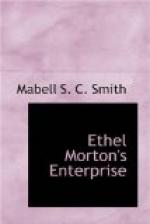“Helen is just naturally headed for the teaching profession!” exclaimed James in an undertone.
Helen flushed.
“I do seem to be asking about a million questions, don’t I?” she responded good naturedly.
“The rose leaf is feather-shaped and the horse-chestnut is palm-shaped,” Ethel Blue thought aloud, frowning delicately as she spoke. “They’re like those different kinds of veining.”
“That’s it exactly,” commended her cousin. “Those leaves are ’pinnately compound’ and ‘palmately compound’ according as their leaflets are arranged like a feather or like the palm of your hand. When you begin to notice the edges of leaves you see that there is about every degree of cutting between the margin that is quite smooth and the margin that is so deeply cut that it is almost a compound leaf. It is never a real compound leaf, though, unless the leaflets are truly separate and all belong on one common stalk.”
“My lily of the valley leaf has a perfectly smooth edge,” said Ethel Blue.
“That is called ‘entire.’ This elm leaf of mine has a ‘serrate’ edge with the teeth pointing forward like the teeth of a saw. When they point outward like the spines of a holly leaf they are ’dentate-’toothed. The border of a nasturtium leaf is ‘crenate’ or scalloped. Most honeysuckles have a ‘wavy’ margin. When there are sharp, deep notches such as there are on the upper leaves of the field daisy, the edge is called ‘cut.’”
“This oak leaf is ‘cut,’ then.”
“When the cuts are as deep as those the leaf is ‘cleft.’ When they go about half way to the midrib, as in the hepatica, it is ‘lobed’ and when they almost reach the midrib as they do in the poppy it is ‘parted.’”
[Illustration: Dentate Wavy]
“Which makes me think our ways must part if James and I are to get home in time for dinner,” said Margaret.
“There’s our werwolf down in the field again,” exclaimed Dorothy, peering through the bushes toward the meadow where a man was stooping and standing, examining what he took up from the ground.
“Let’s go through the field and see what he’s doing,” exclaimed Roger. “He’s been here so many times he must have some purpose.”
But when they passed him he was merely looking at a flower through a small magnifying glass. He said “Good-afternoon” to them, and they saw as they looked back, that he kept on with his bending and rising and examination.
“He’s like us, students of botany,” laughed Ethel Blue. “We ought to have asked him to Helen’s class this afternoon.”
“I don’t like his looks,” Dorothy decided. “He makes me uncomfortable. I wish he wouldn’t come here.”
Roger turned back to take another look and shook his head thoughtfully.
“Me neither,” he remarked concisely, and then added as if to take the thoughts of the girls off the subject, “Here’s a wild strawberry plant for your indoor strawberry bed, Ethel Brown,” and launched into the recitation of an anonymous poem he had recently found.




